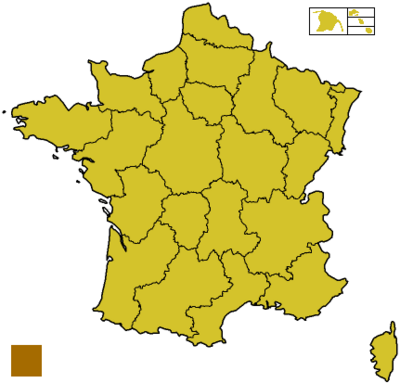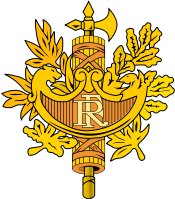Administrative divisions of France
|
|
Contents |
Metropolitan France
As of January 1, 2008, metropolitan France is divided into:[1]
- 22 regions (including Corsica, although strictly speaking Corsica is designated as a "territorial collectivity", not a region, but it is most often called a region in common speech and grouped with the other regions)
- the regions are subdivided into 96 departments
- the departments are in turn divided into 330 arrondissements
- the arrondissements are then divided into 3,883 cantons
- the cantons are subdivided into 36,569 communes (although some of the larger communes actually are composed of several cantons)
- 3 communes (Paris, Marseille, and Lyon) are further divided into 45 municipal arrondissements
- there also exist 730 associated communes (as of January 2006), formerly independent communes which were merged with larger communes but have retained some limited degree of autonomy (e.g. the commune of Lomme which was absorbed by Lille in 2000 and transformed into an "associated commune" inside the commune of Lille)
Furthermore, as of January 1, 2008, there exist 2,568 intercommunal structures grouping 33,549 communes (91.7% of all the communes of metropolitan France), with 86.9% of the population of metropolitan France living in them.[2] These intercommunal structures are:
- 14 Urban communities (communautés urbaines, or CU)
- 165 Agglomeration communities (communautés d'agglomération, or CA)
- 2,384 Commune communities (communautés de communes, or CC)
- 5 Syndicates of New Agglomeration (syndicats d'agglomération nouvelle, or SAN), a category being phased out
Overseas
The French Republic is further made up of the following overseas administrative divisions:
- 4 overseas regions (régions d'outre-mer, or ROM): Guadeloupe, French Guiana, Martinique, and Réunion, which have the same status as metropolitan regions (as much as Hawaii has the same status as a continental US state).
-
-
- each overseas regions is coextensive with an overseas department (département d'outre-mer, or DOM), again with the same status as departments in metropolitan France. The four overseas departments were created in 1946 and preceded the four overseas regions. The dual structure overseas region/overseas department, with two separate assemblies administering the same territory, results from the extension of the regional scheme to the overseas departments in the 1970s. Each overseas region/department may transform into a single structure, with the merger of the regional and departmental assemblies, but voters in Martinique and Guadeloupe rejected this in two referendums in 2003. In Réunion the creation of a second department for the southern part of the island has been debated for some time.
- the overseas departments are subdivided into 12 arrondissements
- the 12 arrondissements are further subdivided into 153 cantons
- the 153 cantons are composed of 112 communes (in the 4 DOM, there are more cantons than communes, unlike in metropolitan France, because many communes are divided into several cantons, whereas in metropolitan France in general cantons are made up of several communes, except in large communes like Toulouse or Lille which are divided into several cantons)
- Furthermore, as of January 1, 2008, there exist 15 intercommunal structures in the overseas departments, grouping 87 communes (77.7% of all the communes of the overseas departments), with 78.6% of the population of the overseas departments living in them intercommunal structures.[2] These intercommunal structures are:
-
- 6 Agglomeration communities
- 9 Commune communities
-
- 6 overseas collectivities (collectivités d'outre-mer, or COM): French Polynesia, Mayotte, Saint-Barthélemy, Saint-Martin, Saint-Pierre and Miquelon and Wallis and Futuna
-
-
- French Polynesia (designated as an "overseas country", French: pays d'outre-mer) is divided into 5 administrative subdivisions (subdivisions administratives). For elections it is divided into 6 electoral districts (circonscriptions électorales) which differ slightly from the 5 administrative subdivisions. The 5 administrative subdivisions are divided into 48 communes. There also exist some associated communes as in metropolitan France.
- Mayotte (designated as a "departmental collectivity", French: collectivité départementale) is divided into 17 communes with no arrondissements. There are also 19 cantons matching exactly the communes except in the case of the commune of Mamoudzou which is divided into three cantons.
- Saint-Barthélemy (designated as a "collectivity", French: collectivité) is a new overseas collectivity created on February 22, 2007. It was previously a commune inside the Guadeloupe department. The commune structure was abolished and Saint-Barthélemy is now one of only three permanently inhabited territories of the French Republic with no commune structure. There are no cantons and arrondissements either.
- Saint-Martin (designated as a "collectivity", French: collectivité) is also a new overseas collectivity created on February 22, 2007. It was also previously a commune inside the Guadeloupe department. The commune structure was abolished and Saint-Martin is now one of only three permanently inhabited territories of the French Republic with no commune structure. There are no cantons and arrondissements either.
- Saint-Pierre and Miquelon (designated as a "territorial collectivity", French: collectivité territoriale, the same designation as Corsica which is a region and not an overseas collectivity) is divided into 2 communes with no arrondissements or cantons.
- Wallis and Futuna (designated as a "territory", French: territoire) is divided into 3 districts (circonscriptions territoriales) which exactly match the three traditional chiefdoms (royaumes coutumiers) with their traditional kings still at their head, the only kings currently recognized in the French Republic. These 3 districts are: Uvea, Sigave, and Alo. Uvea is the most populous and is further divided into 3 wards (districts in French): Hahake, Mua, and Hihifo. Wallis and Futuna is one of only three permanently inhabited territories of the French Republic with no communes (the others being Saint-Barthélemy and Saint-Martin). It also has no arrondissements or cantons.
-
- 1 sui generis collectivity (collectivité sui generis): New Caledonia, whose status is unique in the French Republic: it is the only French local government which is not a territorial collectivity (although its subdivisions are territorial collectivities). A self-determination referendum is scheduled for 2014 to decide the future status of the New Caledonia.
-
-
- It is divided into 3 provinces
- the provinces are subdivided into 33 communes
-
- 1 overseas territory (territoire d'outre-mer, or TOM): the French Southern and Antarctic Lands, which have no permanent population and no communes.
-
-
- the French Southern and Antarctic Lands are divided into 5 districts (districts in French):
- 1. Kerguelen Islands
- 2. Crozet Islands
- 3. Amsterdam Island and Saint Paul Island
- 4. Adelie Land.
- 5. the Scattered Islands (îles Éparses), a collection of five non permanently inhabited islands in the Indian Ocean: Bassas da India, Europa, Juan de Nova, Glorioso, and Tromelin. These were previously administered separately but they have been joined with the French Southern and Antarctic Lands since February 2007.
-
- Uninhabited island which belongs directly to the central State public land:
-
-
- Clipperton Island: uninhabited island in the Pacific Ocean off the coast of Mexico which is directly under the authority of the Minister of Overseas France in Paris (until February 2007 it was administered by the high-commissioner of the French Republic in French Polynesia). Since the Scattered Islands were joined with the French Southern and Antarctic Lands also in February 2007, Clipperton Island is now the only island left in this category.
-
Territorial collectivities
French administrative subdivisions that have a (limited) freedom of administration are called territorial collectivities. Among them are regions, departments, communes, overseas collectivities, provinces (New Caledonia) and the territorial collectivity of Corsica which belongs to no category (but is close to regions). New Caledonia is unique as it is not a territorial collectivity.
General rules
Citizens from all parts of France, including the overseas administrative divisions, vote in national elections (presidential, legislative), and all of the collectivities are represented in the Senate.
List of departments by region

|
|

de Calais
Normandie
Ardenne
Normandie
Charentes
Roussillon
Côte d'Azur
Biscay
Historical divisions
Historically, France was divided into provinces; see Provinces of France.
See also
- List of fifteen largest French metropolitan areas by population
- French overseas departments and territories
- Zone d'études et d'aménagement du territoire (ZEAT), the eight statistical divisions of metropolitan (mainland) France.
References
- ↑ (French) INSEE, Government of France. "Code officiel géographique - Présentation". Retrieved on 2008-06-27.
- ↑ 2.0 2.1 (French) Direction générale des collectivités locales (DGCL), Ministry of the Interior. "L'intercommunalité: composition, listes, statistiques et cartes - Au 1er janvier 2008". Retrieved on 2008-06-27.
External links
|
|||||||||||

